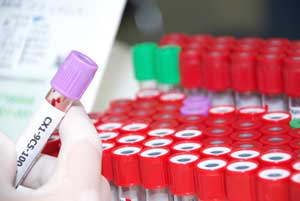During the past decade, send-out test volumes have grown steadily in many laboratories. This trend can be attributed to increases in the number of available tests, especially genetic tests, as well as proprietary tests that must be sent to specific laboratories. These tests involve more steps and more manual processes than in-house tests, thereby increasing the risk of errors that can cause patient harm (Table 1).
|
Table 1
Send-out Test Errors That Can Harm Patients
|
| Preanalytic |
Incorrect test order placed by physician results in delay in receiving results. |
| Preanalytic |
Delay in sending out the test leads to delays in diagnosis or monitoring. |
| Postanalytic |
Delay in entering test result after receiving it from the send-out lab. |
| Postanalytic |
Failure of physician to retrieve results leads to missed or delayed diagnosis. |
| Postanalytic |
Data entry error occurs when manually entering the result leads to physician misinterpretation of result. |
| Postanalytic |
Physician misinterprets a long, complex send-out report that she has little experience in reading. |
While this growth trend is not likely to turn around any time soon, there are interventions that prudent laboratory managers can implement to improve the quality of send-out tests and decrease the risk of errors and patient harm. The interventions fall into two phases of the testing process: preanalytic and postanalytic.
Preanalytical Interventions
There are multiple interventions in the preanalytic phase that laboratory managers can put in place, some even before the test is ordered, to improve quality (Table 2). Having computer interfaces with the reference labs reduces transcription and interpretation errors and provides greater clarity in the process. Similarly, using as few outside labs as possible avoids errors associated with variations in each lab's processing requirements and reduces the complexity of send-out testing.
Labs also can reduce errors by improving how send-out related phone calls are handled. The goal is to have a low rate of abandoned calls and a high rate of questions asked by physicians or nurses answered without transferring calls. Imagine a provider’s frustration because he or she needs to ask a laboratory send-out expert for help but can’t get through on the phone. One way to accomplish this goal is by implementing a dedicated phone center that includes knowledgeable staff.

Labs can improve the quality of send-out tests
by implementing effective lab management practices
that open up the channels of communication
between the lab and patients.
Another place to implement interventions is in the specimen processing area. The longer specimens are delayed in the processing area, the more likely they will be misplaced or handled inappropriately. We found in our own evaluation of send-outs that the lab used different refrigerators and freezers for holding send-out specimens before transport. This increased the likelihood of delays due to mishandling or forgetting specimens. In the worst cases, tests had to be canceled and specimens had to be recollected from patients. When we simplified the send-out process, we shortened the time it took to transport the specimen from our lab to the reference lab, which led to better overall turnaround times and fewer canceled tests.
Perhaps the best way to improve preanalytical process quality is active test utilization management. This might include developing a lab formulary (1), hiring a genetic counselor to review all genetic orders (2), or having a doctoral-level consultant on-call to help with problem cases. In addition, defining as many tests as possible in the laboratory information system (LIS) will simplify send-out processes and decrease exception handling.
The final preanalytic intervention is the one most labs are most familiar with: adding high-volume send-out tests to the lab's menu. Laboratory managers should regularly review send-out orders to determine if it would make sense to perform some tests in-house rather than send them out.
Postanalytic Interventions
Laboratory managers also can make a difference in the postanalytical phase of send-out testing (Table 2). Here, interventions center on efficient and reliable methods to get results back to providers and patients. Entering test results in the LIS can be improved in several ways, including electronically interfacing as many results as possible, scanning the results that cannot be interfaced, and implementing special processes for manual data entry.
|
Table 2
10 Ways to Improve Quality of Send-out Tests
|
| Preanalytic |
Postanalytic |
- Establish computer interfaces to major reference labs.
- Consolidate to as few reference labs as possible.
- Establish a call center to answer provider questions.
- Get the specimens out the door as quickly as possible.
- Implement active test utilization management.
- Define as many tests as possible in the LIS.
- Adjust in-house test menu as needed.
|
- Establish computer interfaces as much as possible.
- Have a system to ensure physician acknowledgement of results.
- Develop quality metrics to ensure the other nine areas are in control.
|
Electronic interfacing is the preferred way to transfer results from the send-out lab to the LIS. Interfacing can be difficult, time-consuming, and expensive, and some esoteric labs do not have an interfacing option; however, a growing number of companies specialize in implementing electronic communication between laboratories. When interfacing is not feasible, installing a scanning system to download the image of the result directly into both the LIS and the electronic medical record (EMR) is a second option. This is especially important for complex, lengthy reports.
Typically, there’s no way to avoid some manual data entry of send-out test results. Labs can reduce the chance of manual data entry errors by instituting redundant data entry and double-checking with accountability. Redundant data entry involves two people entering the same result independently and having the result verified only if these independent entries match. With double-checking, a second person verifies what another staff member entered. Both subsequently sign-off on the result.
By whatever means results accurately make their way into the EMR, ideally there will be some type of EMR functionality or other process that encourages physicians to retrieve and acknowledge those results. (See Box, below) (3,4). This reduces potential harm to patients due to missed abnormal results, especially in those cases where tests take several weeks or months to complete.
Abnormal Send-out Lab ResultsActions to Reduce the Incidence of Failure-to-Notify Patients
- Inform patients that no news about a lab test result is not good news.
- Conduct regular audits by doctoral-level lab staff to determine if abnormal results were acknowledged by a physician, with follow-up when there is no acknowledgement.
- Create automated/semi-automated reports and mail them to patients.
- Send all results to physicians’ electronic inboxes.
- Flag abnormal results in physicians’ electronic inboxes.
- Require care providers to electronically acknowledge viewing.
- Allow patients access to their EMRs.
- Autopage abnormal results to physicians’ wide-screen pagers or to on-call physicians.
Adapted from references 2 and 3.
Quality metrics for send-out testing that monitor the nine areas mentioned previously also can decrease the likelihood of patient harm. For example, labs that use phone call handling software can monitor the abandoned call rate and the time-to-first answer. In addition, labs can set-up send-out test tallies to review the highest volume tests and reference labs. These data help inform decisions about which tests to bring in-house and which reference labs your lab should establish a computer interface with. Manual tallies that track how quickly manual results are entered in the EMR, as well as the rate of corrected reports due to transcription errors also are helpful. Other metrics include: tracking how long it takes for providers to acknowledge results; systematically reviewing test utilization management to ensure management decisions are consistent; and recording the number of undefined send-out tests to look for opportunities to decrease costs.
The Goal: Improved Patient Safety
Implementing send-out improvements will improve the quality of this category of tests, which will directly impact patient care and enhance lab efficiency.
REFERENCES
- Malone B. The Future of Lab Utilization Management. Clinical Laboratory News 2012;38(1):1. Available online.
- Astion ML. Failure to report lab test results to outpatients. Clinical Laboratory News 2009;35(10):18.
- Miller, C. Making sense of genetic tests. Clinical Laboratory News 2012;38(2):15. Available online.
- Casalino LP, Dunham D, Chin MH, et al. Frequency of failure to inform patients of clinically significant outpatient test results. Arch Intern Med 2009;169:1123–1129.

Jane A. Dickerson, PhD, is a senior fellow in the Department of Laboratory Medicine, University of Washington, Seattle.
Email

Bonnie Cole, MD, is a clinical assistant professor, Seattle Children’s Hospital.
Email

Michael Astion, MD, PhD, is chair of the Patient Safety Focus Editorial Board, division chief of laboratory medicine, Seattle Children's Hospital, and clinical professor of laboratory medicine, University of Washington, Seattle.
Email